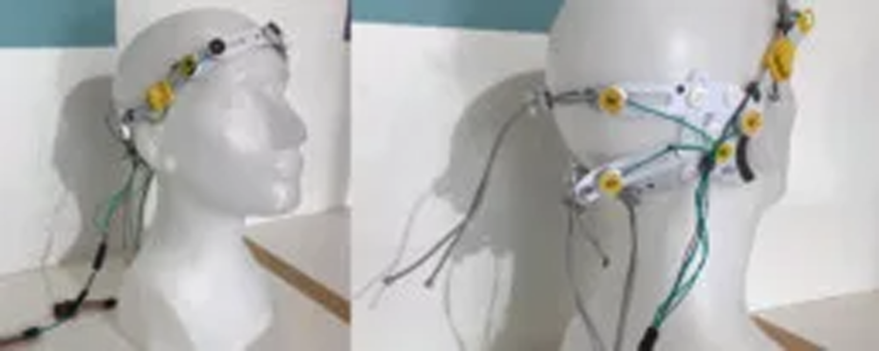If someone's drunk, you can measure their blood alcohol concentration with a breathalyzer. But there's been no equivalent for measuring how high on THC someone is. "In an era of cannabis legalization," writes industrial design firm Shape Products, "reliable impairment detection will become increasingly important for protecting consumer rights and safety in the workplace."
By "consumer rights," they're presumably talking about a purchaser of cannabis; does this pot get me as high as it's supposed to, did the producer measure what this stuff can do? And the latter point about workplace safety is well-taken: You manage a construction crew, Randy shows up a little glassy-eyed, maybe you don't want him working the crane that day.
Shape was hired by Zentrela, a tech company that developed an algorithm that can read a person's EEG results and measure how high they are. Shape's job was to design the physical object, a portable wearable that they call the Cognalyzer. (Apologies for the low-res photos, those are all that was available.)

As for how it works:
A series of electrodes collect electrical signal (sic) and send the information through a proprietary wiring harness and control unit. From here, the data gets transmitted via Bluetooth to a tablet or computer where the analysis takes place. After about 5 minutes of live data collection, Zentrela's algorithms will have enough information to determine the presence of impairment and the extent to which the test subject is impaired. This technology brings unmatched objectivity and clarity to the impairment detection industry while also opening the door for cannabis producers to better test and segment their products.

I do have a couple of criticisms about the design. Before I get to those, we should first understand what the design challenges were:
Testing validity is at the heart of Zentrela's core value proposition and the hardware must match the sophistication of the software upon which the Cognalyzer relies. One of the main challenges was designing the system to be a one-size-fits-all solution while keeping the manufacturing costs down to facilitate mass distribution. In order to optimize for these considerations, we designed the headset around a die-cut frame. Using early prototypes, we continually tested construction and adjustment styles to ensure that electrodes would be easy to position accurately.


The Cognalyzer system is designed for two users, both equally important; the test administrator and the test subject. Cognalyzer tests are designed to be performed in the real world, not in a laboratory setting and, for those administering and receiving tests, it's likely to be the first time interacting with EEG technology. Because of this, the hardware needed to be foolproof and easy to use.


From the administration standpoint, we carefully considered variations in head shape and size and designed the fit system accordingly. Eight of the ten electrodes can be accurately positioned and checked for signal quality regardless of head size or brain position within the skull. To help secure these electrodes in place for the duration of the test, we designed an electrode that can slide along a track in the die-cut headset to custom-locate on any subject. Our usability and ergonomic testing process was geared towards improving the testing experience for those administering and receiving the test. In addition to speed, we knew that a big part of the experience would come down to subject comfort which is especially important as many of us are predisposed to feel uncomfortable when receiving any type of medical test. To help make the experience more comfortable we added soft materials to the die-cut edges and electrode bodies that would come in contact with subjects' skin and head.
[Zentrela's feedback] was instrumental in getting to a final product that strikes a balance between, subject comfort, ease of testing, and of course, medical validity.
So assuming the points they needed to hit from the design brief were physical comfort, ease of testing and medical validity, I can assume they've reached their benchmarks. Thus my criticisms may not be fair because they're outside of the design brief. I'll air them anyway, for the purpose of discussion.
My take is that while the device may be comfortable to wear, with well-considered touchpoints, it doesn't look comfortable. That's fine if I'm a professional marijuana producer testing out my product, like a farmer taking a soil sample--you don't care what the tool looks like, as long as it works well.
However, if I show up for work and my boss thinks I'm high, and asks me to strap this thing on, I'm going to be resistant. In my opinion and within this context, the device looks cold and clinical, or like some kind of torture device from a sci-fi movie. I don't want to be ordered to don this.

And my main concern, given recent events, is how this object would be used in a law-enforcement capacity. If I get pulled over--and if I'm a black person, who is likely already terrified--the last thing I want to do is let a police officer put this onto my head.


I understand that this object's design is form-follows-function, and I'm sure it works for providing readings. But I would want to see an equally important secondary function in the design brief, which is to consider the contexts in which this item might be used, and what the perception of it will be to the perhaps unwilling wearer.
That's just my two cents. Your thoughts?
from Core77 https://ift.tt/3ij02Av
via IFTTT

No comments:
Post a Comment